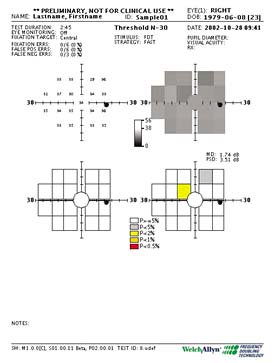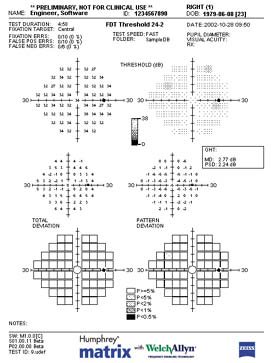What’s new in glaucoma practice
I recently gave a series of short talks with Howard Barnebey, MD, on different topics related to glaucoma. One talk presented by Dr. Barnebey was titled, “What am I doing differently this year?” I found this to be such a great topic that I will devote this column to it, addressing what I have been doing differently over the last several years.
Importance of IOP
|
Probably the most important change to occur recently is the recognition that intraocular pressure is crucial to both the diagnosis and management of glaucoma. In study after study, the higher the IOP, the greater the risk for developing damage or the progression of damage.
This doesn’t mean that every individual requires a target pressure of 12 mm Hg, but the days of our following glaucoma patients with IOPs around 21 mm Hg are gone. The range of pressures needed to stabilize an individual are unknown, though we attempt to achieve IOPs lower than before.
Diurnal variability is a hallmark of both ocular hypertension and glaucoma, though it can be overlooked if we rely on a single IOP measurement before therapy is begun. In both groups, the IOP may change up to 10 to 15 mm Hg within a 24-hour period.
I try to obtain several IOP readings, either on 1 day or several days grouped closely together to better understand the range of IOP before I initiate therapy. Still, this only provides a diurnal type curve before therapy is initiated. Individuals who are progressing may have IOPs that vary throughout the day. With a lone measurement, we may have a false sense of security regarding IOP control.
Another method to obtain a diurnal curve is with the Proview Home Tonometer (Bausch & Lomb, Rochester, N.Y.). This instrument is purchased by the patient, usually for about $65. It is available without a prescription at many pharmacies. In about 15 minutes the patient can be taught how to use it in the office. The patient then keeps a log of IOP readings, with the first week’s measures discarded due to the learning curve. Readings become repeatable after about 7 days of use. Readings are taken several times a day, with the patient bringing his or her logbook to appointments. While the Proview tonometer often underestimates IOP measurements, we are looking for spikes or variations in IOP.
True IOP
We also need to understand our patient’s “true” IOP. Diurnal curves are one method of understanding the overall variation in IOP throughout the day, but we also need to account for corneal thickness and its impact on our readings. Recently, we have come to understand that eyes have very different corneal thicknesses, and this is not due to corneal disease. Thicker corneas will overestimate the tonometry reading, while thinner corneas will underreport the measure. Recent studies have pointed out the importance of pachymetry and its ability to correct IOP and highlight patients at greater risk for converting from ocular hypertension to glaucoma.
The use of pachymetry to measure corneal thickness has become an important test as I evaluate individuals with ocular hypertension, with suspected glaucoma or with glaucoma. It is performed once, with the results recorded in the patient’s chart as well as at the top of the glaucoma flow sheet so that the information will always be visible. Pachymetry allows me to better understand what the IOP is within the eye. I use a base of 545 µm as the normal value, adding or subtracting 1 mm for each 20 µm of change.
The effect of corneal thickness on IOP is not linear, and I mentally note larger effects as the thickness falls into the 400s. Thin corneas are more commonly seen in African Americans. A cornea with a thickness of 500 µm will have a tonometry reading that is approximately 2.5 mm Hg too low, while a 600-µm thick cornea will read about 2.5 mm Hg on the high side. Pachymetry is not part of the comprehensive vision analysis but is indicated when glaucoma is suspected or observed.
A suspicious optic nerve with questionable visual fields and an IOP of 18 mm Hg will be followed differently if the corneal thickness is 450 µm vs. 550 µm or 650 µm. The pachymeter I use, the Pachette 2 by DGH (Exton, Pa.), is set to take 10 readings automatically and then create an average of these readings. The mean is the measure I place in the chart, with the entire test taking only several seconds. Now that pachymetry is part of my glaucoma evaluation, I don’t know how I managed glaucoma without it.
Optic nerve imaging
Optic nerve imaging has become another important test for individuals being managed for ocular hypertension, suspicious optic nerves or glaucoma. The instrument(s) can be used either to help establish the diagnosis or for detecting progression. I use the information from imaging to supplement other data when deciding whether therapy is indicated or must be modified.
The problem with imaging in all its forms is that there is overlap in the optic nerve measurements (cup size, rim area, depth, volume) and nerve fiber layer thickness between normal and abnormal individuals. The instruments attempt to differentiate the diseased eyes from normal eyes, but it is a difficult task with some over- or under-calls. I am more interested in using imaging to follow patients for progression or change over time.
Images are taken yearly (possibly more often than this), recognizing that serial analysis will become useful several years later. Currently, Heidelberg’s HRT II (Vista, Calif.) has the most sophisticated glaucoma probability change program, but other companies with imaging technologies recognize the need to develop software to highlight change based upon glaucomatous individuals. The issue is that a difference may occur when parameters from one test are compared to another. The differences may not relate to real change but rather to individual, operator and instrument variability. The instrument must be designed to recognize how much change is needed to be consistent with glaucoma progression and not simply variation.
Perimetry, early detection
|
Perimetry for early detection has been an elusive goal. This is one reason why optic nerve and nerve fiber layer imaging has become an important tool. Threshold perimetry does not detect field defects when glaucomatous damage is at its infancy. Still, there are tools that may detect early functional vision loss but are not commonly used for a variety of reasons.
For example, short wavelength automated perimetry (SWAP) is rarely used because patients being evaluated as glaucoma suspects often are developing lens changes. SWAP in its current form is affected by lens changes and requires a well-focused patient.
Another alternative is frequency-doubling technology (FDT) perimetry in its threshold mode. The FDT screening test (Carl Zeiss Meditec, Dublin, Calif.) is commonly used, with the threshold test often overlooked. Several studies have shown that FDT Threshold performs similar to SWAP in its ability to detect early visual field changes, even while the standard white-white field is full. The concerns with the FDT in its threshold mode are that fields are not easily storable and that the instrument has limited spatial resolution (only 17 points tested).
The newest version of the FDT, called the Humphrey Matrix (released in March 2003) offers threshold tests with 10-2, 24-2 and 30-2 patterns. This is similar to the more commonly used patterns of other perimeters. Concerns about spatial resolution should be rectified and may allow early field changes to be detected. The target size is 5° x 5°, which is considerably smaller than the current 10° x 10° target size. Three studies were submitted to ARVO that compare the Humphrey Matrix to conventional perimetry, and future studies will determine how well the Humphrey Matrix performs as compared to SWAP and other modalities in detecting glaucomatous damage.
The Ocular Hypertension Treatment Study (OHTS) clarified to a great extent which patients with elevated IOP, healthy optic nerves and full visual fields require preventive therapy. I now take into account corneal thickness, IOP and cup-to-disk ratio to come to a risk assessment. As the cornea thins (below 520 µm), cupping gets larger (0.5 or greater) or IOP increases (25 mm Hg), the risk elevates significantly. When two of these factors are seen, risk is very high, and therapy should be considered. If all three are seen, therapy is recommended. Other factors that I also take into account include family history, age, whether the patient is monocular and systemic medical history.
Changes in therapy
The major change regarding the treatment of glaucoma is that topical prostaglandins have become the most common agent used initially. There are several reasons for this: their safety, efficacy, ease of use and ability to blunt diurnal spikes. Also, if a dose is missed, the IOP will stay reduced for anywhere from 48 to 84 hours after the last drop was instilled. Still, side effects such as hyperemia must be explained to patients.
With three effective agents in this class (latanoprost, travoprost and bimatoprost), if one does not achieve the target IOP, switching to another in the class often achieves the goal. I have been amazed that reductions of 40% to 50% are commonly seen — levels I thought were impossible not long ago. If a second agent is needed for further IOP control, I often use topical carbonic anhydrase inhibitors (CAIs) with a twice-daily dosage. Dr. Barnebey first pointed out to me the disappointment when a beta-blocker is added to a prostaglandin. Topical CAIs used instead of beta-blockers or alpha-agonists in the second-line role often achieve synergy with prostaglandins, showing an additional 15% reduction in IOP.
Still, beta-blockers have not left my practice. The OHTS study revealed how safe this class of medications is, especially when patients are carefully screened for known contraindications. Beta-blockers are cost-effective and easy to use (once per day in the morning) with few side effects. Another reason why beta-blockers are not as commonly used — in addition to the efficacy of prostaglandins — is that many elderly individuals are taking oral beta-blockers for cardiovascular conditions with some IOP reduction present. It is not clear if further IOP reduction is gained when topical beta-blockers are added to a patient already using systemic beta-blockers.
Finally, I rarely will have a patient use more than two bottles of medications. If additional IOP reduction is needed and two bottles are being used, I would consider a referral for laser trabeculoplasty. This does depend upon the patient’s age, form of glaucoma, IOP level and other factors.
What am I doing differently now? Well, the care of patients with glaucoma is evolving before my eyes. Recently introduced technology is becoming commonly used to help us evaluate the IOP, visual fields or optic nerve. In regard to therapy, prostaglandins have become the first-line agent of choice and are used to maintain a low level throughout the entire day. It will be interesting to see over time if these changes translate to our glaucoma patients having reduced damage commonly associated with glaucoma.


